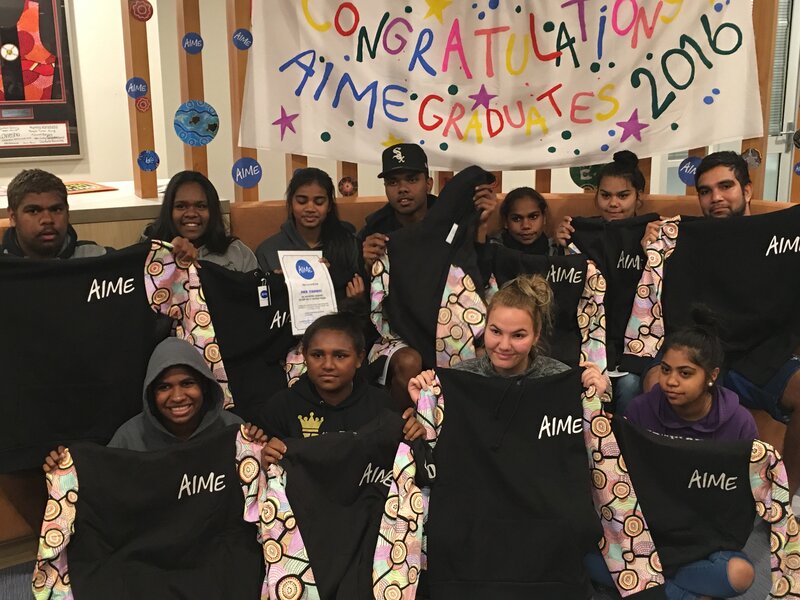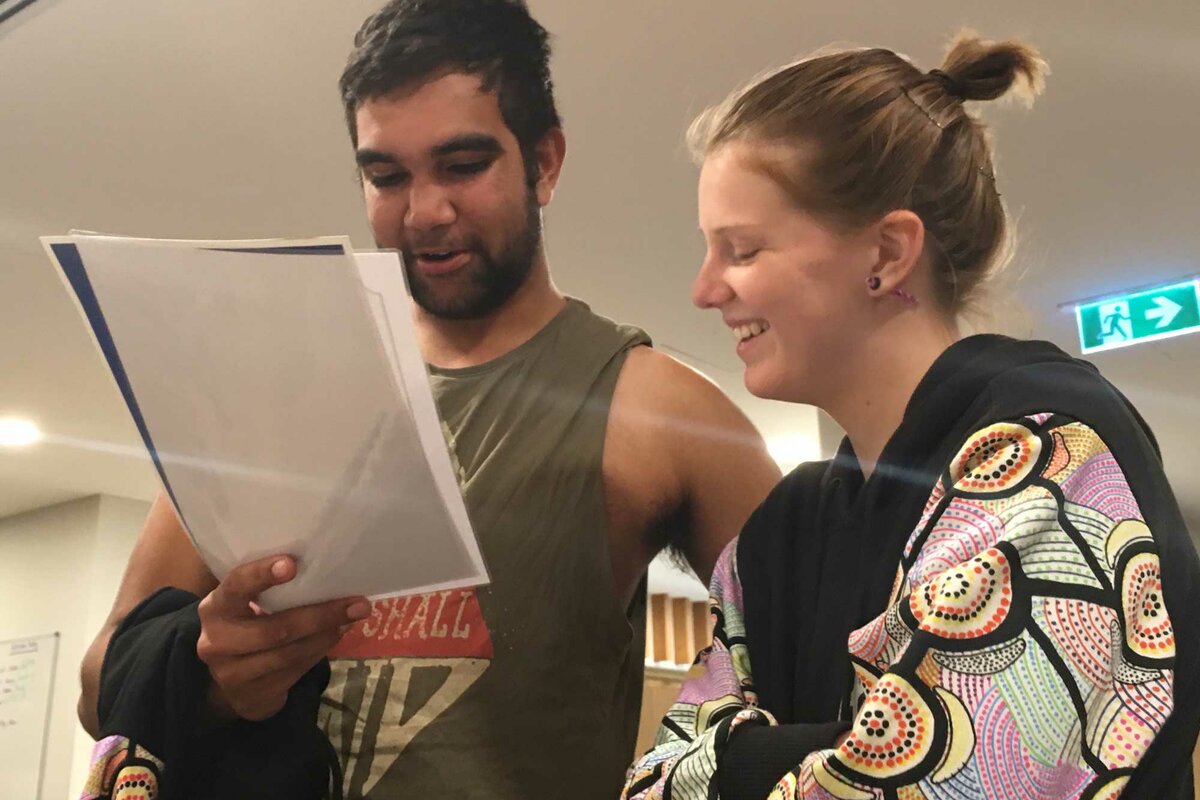How mentoring helps Aboriginal teens create new futures
Loading...
| Perth, Australia
Jason Anketell remembers his early teen years growing up in Tennant Creek, a remote town of about 3,000 planted in the middle of Australia’s hot, sparsely populated Northern Territory.
Until the middle of 10th grade, says Mr. Anketell, an Aboriginal man from the Warumungu language group, he was at loose ends, getting into fights and “mingling with the wrong people” on streets tinged red by the dust of the rusted landscape.
Somewhere amid the chaos of “alcohol, drugs, and domestic violence,” a well-worn narrative in many rural Aboriginal communities, he began to “think twice – this is not the life I want in the future.”
Around that time, a youth worker pushed him to travel more than 2,500 miles to board at the Clontarf Aboriginal College, in Western Australia’s capital, Perth. Soon after he arrived, a school staff member suggested he get involved with the dedicated Aboriginal youth mentoring program AIME (Australian Indigenous Mentoring Experience).
“Since then I’ve just been meeting with new people, being proud of who I am,” Anketell says. “AIME is the only one who makes me feel confident enough to feel proud, to feel strong.”
That increased confidence is always the No. 1 thing any young person feels as the result of connecting with a mentor who cares about them, according to Judy MacCallum, an associate professor at Murdoch University’s School of Education. But, some Aboriginal people say, discovering a sense of self-worth can be a particularly steep climb for indigenous youth whose ancestral past includes mass killings, land dispossession, and denial of basic rights for much of white history.
“We have a saying: No shame at AIME,” says Jason Burton, AIME’s center manager for Curtin and Murdoch Universities in Western Australia, at the Clontarf AIME grade 12 graduation night. ‘“We like to say ‘indigenous equals success’ – we want to say, 'You guys are already successful, you're the oldest living culture on earth, you’re resilient.' It’s almost been beaten into them not to come out of their shells, but we're saying: Now there's nothing holding you back.”
Many top-down government programs have fallen short on winding back chronic inequalities such as a shorter life expectancy, disproportionate rates of incarceration, and poverty. Over the past decade, however, a proliferation of dedicated Aboriginal mentoring and scholarship programs like AIME are giving education advocates fresh hope that progress can be made on lifting roughly 160,000 Aboriginal children out of the chronic educational disadvantage that feeds such problems.
Unlike periodic government efforts to “close the gap,” these corporate and privately funded nonprofits are created by, or in close collaboration with, Aboriginal people. And, some Aboriginal experts say, the egalitarian relationship between the youth and their often non-indigenous mentors is helping dissolve racial stereotypes as Australia’s national conversation around race and history evolves.
“Aboriginal people are sick and tired of having programs implemented, only to see them taken away or the funding diminished to a point where they’re no longer able to achieve or go about the objective of those programs,” says Graeme Gower, a descendant of the Yawuru people from Broome and senior lecturer at Kurongkurl Katitjin, Edith Cowan University’s Centre for Indigenous Australian Education and Research. “Projects like AIME that have been sustained and have been supported by other funding means they have impact, because things won’t just happen overnight.”
93 percent graduation rate
AIME is still only reaching a sliver of the kids in need, but it has a model it wants to share, with a view to reaching all 160,000 children by 2025. Earlier this month, it also launched a global campaign in the hope others around the world will take its blueprint to help other indigenous and minority people.
Its CEO, Jack Manning Bancroft, along with a number of close friends, launched the program in the Sydney suburb of Redfern about 12 years ago. Starting with 25 mentors and 25 students, it has grown into a national program that this year is connecting about 6,000 9th- to 12th-grade students with about 1,800 mentors.
In 2015, 93 percent of AIME’s 533 12th-grade mentees graduated from high school, exceeding the national nonindigenous rate of 87 percent and the indigenous rate of 59 percent. Roughly three-quarters of those graduates transitioned to university or a job or training, the same as the national nonindigenous average. AIME follows up with all its students for two years after they leave high school to make sure they’re still on track.
To do this, the program partners with 17 universities, from which it draws its volunteer mentors. These mentors help run sessions with students from surrounding schools. The sessions range from drama, hip-hop, or writing a speech as if they were prime minister, to life skills like résumé-building and goal-setting for their transition after graduation. Additionally, mentors get together with students once a week for “tutor squad,” helping them with homework. They sometimes act as a go-between when the teens aren’t comfortable talking directly with their school teachers.
For Anketell, it’s an approach that, in a few years, has transformed the 18-year-old’s outlook. Three weeks before he becomes the first person in his family to graduate from high school, he says, he just wants to be a “hard-working man.” That could mean staying in Perth and getting work in civic construction or heading back home to work as a mechanic.
Still, the program is far from perfect, observers say. For one, its model means it's still not reaching many kids with the highest needs in remote communities. Also, while AIME's model of drawing mentors from the university student pool has allowed them to grow quickly, levels of mentor commitment vary.
Even so, the two-way relationships Aboriginal students are building with their diverse, nonindigenous Australian and international student mentors are helping to wear down some ingrained stereotypes and giving Aboriginal people more of a voice, AIME folks and Mr. Gower say.
Mentor training is case in point. For the first hour, a roomful of mentors sit quietly, listening to the stories of four 11th-grade students. They ask them questions about everything from being racially bullied to how they could be better mentors. One mentee, Bailey, reminds them: “Remember, you can learn from us, too.”
Australia takes fresh look at race and history
In many ways, what’s happening at AIME is indicative of a new wave in Australia’s national conversation around race and history. For one, talk of changing the date of Australia Day – the day marking the 1788 landing of the First Fleet of British colonists at Botany Bay near Sydney, which some people refer to as invasion day – has entered the mainstream. Aboriginal people have been breaking down professional barriers and speaking out explicitly against racism, sometimes sparking an angry backlash.
Last year, Linda Burney, who is Wiradjuri, became the first aboriginal woman to be elected to a federal lower house seat from Barton, in New South Wales. Sky News foreign correspondent Stan Grant, also Wiradjuri, gave a speech that went viral in which he declared that the Australian dream is rooted in racism.
Sharna Ninyette, program manager for AIME at the University of Notre Dame's Fremantle campus in Western Australia, believes that the number of nonindigenous voices willing to speak out in public forums against racism has grown.
“There’s actually a bigger group of non-Aboriginal people that stand up to say, ‘That’s not cool,’ " she says. "That is something you would not have seen five or 10 years ago, and that for these young fellas is exciting because they’ve got people standing with them. Whereas when I was in school and it happened to me, it was very isolating.”
Indeed, the education picture has brightened considerably. Until the late 1940s, Aboriginal kids weren’t allowed to attend public schools, according to Dr. Gower. Between about 1910 and 1970, the so-called “stolen generations” of children were systematically whisked from their parents and placed far away on religious missions, which attempted to assimilate them.
Today, more Aboriginal youth are eager to go further than their grandparents and parents, many of who remember the time before they were granted the right to vote in 1962 – or when they were counted as actual members of the Australian population for the first time in 1971.
Not going home 'empty handed'
Marlee Hutton, a Bardi Jawi woman in her early 20s who hails from the far north of Western Australia, exemplifies her generation’s stretch. Back in high school, she was granted a scholarship to attend Perth’s Iona Presentation College by Madalah, an organization that offers scholarships to Australia's best boarding schools for Aboriginal kids from remote communities, and connects them with mentors.
Ms. Hutton, who has worked for AIME since it expanded to Western Australia in 2012, will graduate from university this year with a double major in marine and environmental science. Ultimately, she says, all the years she has spent in the city have not watered down her connection to culture or “country.” She wants to return home, but not until she’s qualified and empowered to work with her community.
Her high school mentor, Naomi, an Aboriginal woman, stopped her going home “empty-handed” a number of times.
“There were times when I really wanted to go home, but Naomi really ... pushed the fact that I have the ability to do a lot more than I think I can," she says, "and it’s important that I do something, and don’t just give up and go back home.”








